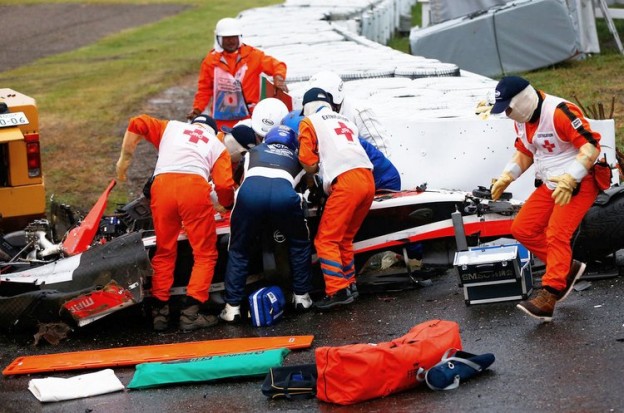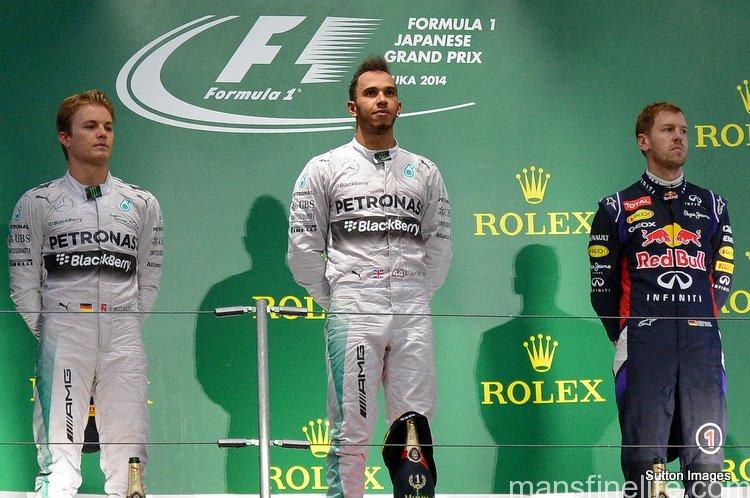The Formula 1 Japanese Grand Prix, already under threat from a menacing offshore typhoon, was marred by a freak accident in rapidly deteriorating weather late in the race when Marussia driver Jules Bianchi lost control at Dunlop Curve and collided at high speed with a recovery tractor on the circuit. The promising 24-year-old Frenchman, who scored Marussia’s first and only Championship points at Monaco this year, aquaplaned and his low slung car appeared to submarine the edge of the tractor, which was on the scene attempting to remove Adrian Sutil’s beached Sauber after he had also lost control on that exact corner. Bianchi was taken by ambulance to a local hospital (the mandatory medical helicopter appears to have been grounded by the weather) where he was diagnosed with a severe head injury, underwent emergency surgery and is now listed in critical but stable condition. This is the worst on-track incident in Formula 1 since 2009 when Felipe Massa was hit in the head during Qualifying at the Hungaroring by a spring that had come off of the car in front of him. Having only just seen the recently released video of the incident, this accident looks must worse than Massa’s and I can say without exaggerating that it is remarkable that Bianchi survived the shunt. It is also remarkable that the hurtling vehicle did not collect any of the safety personnel on the scene.
The Bianchi incident prompted a red flag that prematurely ended the race on lap 45 and overshadowed what had been an exciting day of wet weather strategy and dynamic racing. Lewis Hamilton was declared the winner and in truth it looked like no one had anything for the Englishman even had the race gone the full 53-lap distance. Expanding his points lead to 10 over his Mercedes teammate Nico Rosberg after winning this and the previous Grand Prix, Hamilton passed the pole-sitting German forcefully on lap 29 and then ran away from him for good. It seemed that Hamilton had the better set up in the wet and was perhaps also the better driver in such extreme conditions. Red Bull’s Sebastian Vettel, who announced on Saturday that he was leaving the team next year presumably to join Ferrari, had an excellent race. After starting a lowly 9th, the 4-time World Champion showed much of his old flair to charge up through the field and come home 3rd. That was one better than his normally precocious Australian teammate Daniel Ricciardo could muster, but the high finish by the two Red Bulls showed just how good the chassis can be when top line speed is not the most important factor.
Jenson Button very nearly had the best race of anyone not in a Silver Arrow, as he was able to use all his skill and guile amidst the treacherous conditions to bring his McLaren home in P5 after starting 8th. The veteran Englishman, who may be driving his last few F1 races with McLaren if the speculation about Fernado Alonso joining the team next year is correct, had been the first driver to switch to intermediate wet tires when the rain slackened on lap 10 (the entire field had started on full wets behind the Safety Car). Button then set times nearly as fast as the Mercedes duo, cueing the rest of the paddock that the time to change tires was at hand. If not for a costly stall during a later pit stop, Jenson could have had a podium at his favorite Grand Prix. But he did show that he is still more than capable in a top level ride whether Fernando Alonso takes his seat next year or not.
The two Williams of Valtteri Bottas and Felipe Massa finished 6th and 7th respectively and that chassis never seemed to have enough downforce to compete with the frontrunners on the ultra-greasy track. Nico Hulkenberg had a good race for Force India to take 8th after qualifying only 14th on a dry Saturday and teammate Sergio Perez also did well to grab the last Championship point with P10. Jean-Eric Vergne again made his case to stay in F1 with an amazing 9th place finish for Torro Rosso despite starting from 20th position due to a 10-grid spot penalty for an engine change after qualifying.
Scuderia Ferrai had a dismal day, with Fernando Alonso retiring with electronic failure on the 3rd lap when the race was still behind the Safety Car. And while teammate Kimi Raikkonen did finish he could only muster P12 after myriad pit stops that resulted in very little pace. This insured it was the first time in 82 GP that the Prancing Horse came away with a big goose egg on a race Sunday. One wonders whom they’ll fire next.
Top 10 finishers of the shortened Japanese Grand Prix here:
| Pos | No | Driver | Team | Laps | Time/Retired | Grid | Pts |
|---|---|---|---|---|---|---|---|
| 1 | 44 | Lewis Hamilton | Mercedes | 44 | 1:51:43.021 | 2 | 25 |
| 2 | 6 | Nico Rosberg | Mercedes | 44 | +9.1 secs | 1 | 18 |
| 3 | 1 | Sebastian Vettel | Red Bull Racing-Renault | 44 | +29.1 secs | 9 | 15 |
| 4 | 3 | Daniel Ricciardo | Red Bull Racing-Renault | 44 | +38.8 secs | 6 | 12 |
| 5 | 22 | Jenson Button | McLaren-Mercedes | 44 | +67.5 secs | 8 | 10 |
| 6 | 77 | Valtteri Bottas | Williams-Mercedes | 44 | +113.7 secs | 3 | 8 |
| 7 | 19 | Felipe Massa | Williams-Mercedes | 44 | +115.1 secs | 4 | 6 |
| 8 | 27 | Nico Hulkenberg | Force India-Mercedes | 44 | +115.9 secs | 13 | 4 |
| 9 | 25 | Jean-Eric Vergne | STR-Renault | 44 | +127.6 secs | 20 | 2 |
| 10 | 11 | Sergio Perez | Force India-Mercedes | 43 | +1 Lap | 11 | 1 |
Complete results available at Formula1.com.
Obviously, like motorsports fans everywhere, all of us here at MFL wish Jules Bianchi the very fullest and best recovery possible. No doubt this accident will once again revive the debate over mandating closed cockpits in Formula 1, as well as prompting a thorough review of proper trackside safety procedures and appropriate protocols for running in extremely wet weather. It always seems to take a bad shunt to make further improvements to driver safety and in this ultra-safe, post-Senna era of F1 it is all too easy for the powers that be to feel complacent at their uninterrupted success and good luck since 1994. The truth of the matter is that while FIA never stops working to improve safety there is also never too much that can be done to make racing as safe as it possibly can be. After Sunday’s very scary crash, we can only hope that the events leading up to and immediately following the incident will be thoroughly analyzed with that ultimate goal in mind. To say that FIA, the stewards and the track workers did everything perfectly is simply not good enough. There is always something to learn after an accident like this and it should always lead to improved safety. Period.
That said, motor racing will always remain an inherently dangerous pursuit and one that the men and women who practice it engage in willingly. We fans may collectively forget the risks sometimes after a long period of quiet but then an accident like yesterday’s brings the consequences of life at the limit right back into stark perspective. That’s what makes it the remarkable sport that it is: take away all the glamour and technical wizardry and there’s still a competitor willing to wager the highest stakes a person can put on the table.



